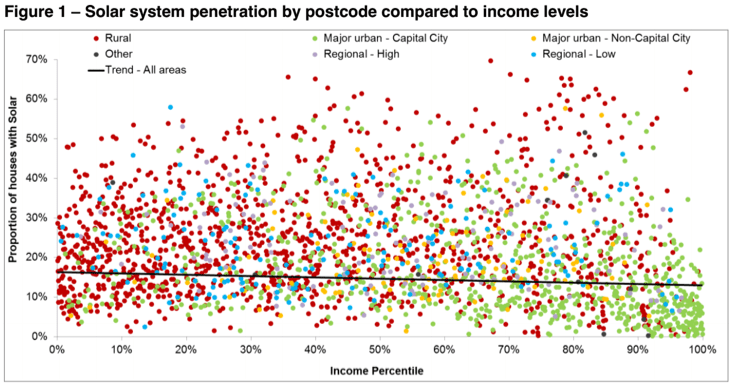Just in case we needed any more evidence to debunk the myth that rooftop solar was a plaything of the rich – or middle class welfare – a new and detailed analysis of solar installations in Australia has shown that lower income families and regional communities are the nation’s most likely to put solar systems on their roofs.
In a study measuring the uptake of solar panels and hot water systems by postcode and income, the REC Agents Association (RAA) has found that, of the top 10 solar suburbs in each Australian state and territory, almost all households had a lower income than the state average.
The analysis, released by the national industry body on Tuesday, also shows more than 40 per cent of solar installs are in rural and regional communities, despite these communities making up only 32 per cent of Australia’s housing stock.
“Installation of solar systems in the capital cities were typically characterised by postcodes in the outer metropolitan mortgage belt,” the RAA report says, pointing to an inverse relationship between average incomes and solar penetration levels; that is, as income levels increased, solar uptake declined.
In the more populated states, the report notes, the suburbs with the most solar installations tended to be outside the capital cities. Of the top 10 postcodes in each state (80 in total across 8 states and territories) 45 per cent were in rural and regional areas, 45 per cent in capital cities and the remaining 10 per cent in other major urban centres.
The findings are along the lines of data published last week by solar installer Energy Matters, showing that Australia’s top three spots for household solar penetration were Browns Plains in outer Brisbane (51%), Perth’s outer southern suburb of Mandurah (46%), and Salisbury – an unassuming suburb 25km north of Adelaide.
According to RAA, the five suburbs in Australia with the largest number of solar systems were the Bundaberg and Hervey Bay areas in Queensland, WA’s Mandurah and Weribee and Hopper’s Crossing in Victoria – all with below state average income levels.
The report also notes that the factors driving rooftop solar uptake in these demographics were most likely to be: level of home ownership; building suitability; relative importance of energy bills; and level of new home and renovation activity.
Fiona O’Hehir, vice president of the RAA, said the results illustrated why Australia’s Renewable Energy Target should be left unchanged.
“RAA’s study reinforces the importance of the Renewable Energy Target to lower income families and people living in rural areas,” O’Hehir said. “Without the RET, lower income households would not be able to reduce their power bills. The RET helps families with the upfront cost of installing solar.”
The Coalition government’s controversial review of the RET – which is widely expected to result in the target being reduced – made what has been described as a “farcial” start to its public deliberations last Wednesday, attracting new accusations of bias and of having a predetermined outcome.
In a discussion paper released early this month, the RET review panel included considerations to remove incentives for small scale renewable energy technologies – namely solar PV – and suggested, instead, a shift of focus to “non renewable” low emissions technologies, such as gas or carbon capture and storage.











